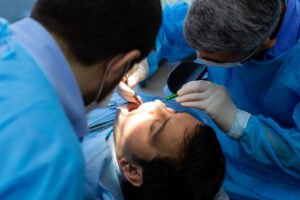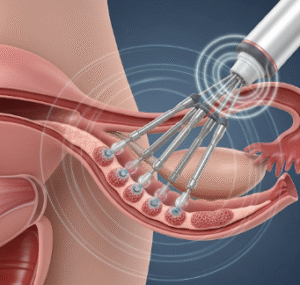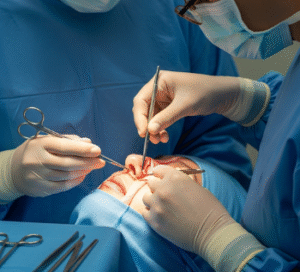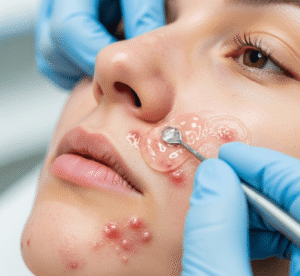Overview
Circumcision is a surgical procedure to remove the foreskin of the penis. It is one of the most commonly performed procedures in boys worldwide and is done for medical, cultural, or religious reasons. The foreskin is a retractable fold of skin that covers the glans of the penis, and removal can reduce the risk of certain infections and medical conditions.
Importance of circumcision in boys:
- Prevents recurrent infections, including urinary tract infections (UTIs).
- Reduces risk of sexually transmitted infections (STIs) later in life.
- Helps prevent phimosis, where the foreskin cannot be retracted.
- Offers hygienic and cultural benefits.
In South Korea, circumcision is commonly performed in infancy or early childhood, mostly in private hospitals and clinics, with a focus on safety, pain management, and minimal complications.
Why It’s Done
Circumcision is performed for medical, preventive, or cultural reasons.
Common indications include:
- ➤ Phimosis: Tight foreskin that cannot be retracted.
- ➤ Recurrent balanitis or urinary tract infections (UTIs).
- ➤ Prevention of sexually transmitted infections (STIs) including HIV.
- ➤ Cultural or religious practices, such as in Muslim or Jewish communities.
- ➤ Parental preference for hygiene or aesthetic reasons.
Benefits for patients:
- ✔️ Reduces risk of infections in the penis.
- ✔️ Prevents painful complications related to foreskin tightness.
- ✔️ Improves personal hygiene and ease of cleaning.
- ✔️ Offers long-term protective benefits in adulthood.
Alternatives
While circumcision is the definitive method, alternatives may be considered for minor issues:
- ➤ Topical steroid creams: Used to loosen tight foreskin in mild phimosis.
- ➤ Preputioplasty: Surgical procedure that widens the foreskin without complete removal.
- ➤ Careful hygiene practices: Regular cleaning of the foreskin can prevent infections in some cases.
- ➤ Observation: Mild foreskin tightness in infants often resolves naturally over time.
Key point: Circumcision is the most effective solution for persistent or severe foreskin problems.
Preparation
Preparation for circumcision in boys involves medical assessment and parental guidance.
Steps include:
- ✅ Medical history review: Assess for bleeding disorders, chronic illnesses, or previous surgeries.
- ✅ Physical examination: Evaluate foreskin condition and overall penile anatomy.
- ✅ Consent: Obtain parental consent and explain procedure, risks, and recovery.
- ✅ Fasting: Required for older children undergoing general anesthesia; infants may not require fasting.
- ✅ Pain management plan: Local anesthesia for infants, general anesthesia for older children.
Important: Proper preparation ensures safety, reduces anxiety, and improves postoperative outcomes.
How It’s Done
Circumcision is performed using surgical techniques under anesthesia.
Procedure options:
- Gomco clamp or Plastibell device: Common in infants; foreskin removed safely with minimal bleeding.
- Conventional surgical method: Performed under local or general anesthesia; surgeon excises foreskin and sutures edges.
Step-by-step process:
- Anesthesia: Local (infants) or general (older children).
- Cleaning and sterilization: Area disinfected.
- Foreskin removal: Surgical technique chosen by the surgeon.
- Hemostasis: Control of bleeding using clamps or sutures.
- Dressing: Small dressing applied to protect wound.
- Observation: Short recovery in hospital or outpatient clinic.
Duration:
- Infants: 5–15 minutes
- Older children: 20–40 minutes
Hospital stay: Usually outpatient; same-day discharge.
Key point: Circumcision is safe, quick, and performed with minimal discomfort under anesthesia.
Recovery & Postoperative Care
Recovery depends on age and surgical technique, but is generally rapid.
Immediate post-procedure:
- Monitor for bleeding, swelling, or pain.
- Pain relief administered as needed (acetaminophen or infant analgesics).
- Apply gentle pressure or dressings as advised.
Short-term care:
- Keep area clean and dry.
- Avoid swimming, baths, or rough activity for 5–7 days.
- Monitor for signs of infection: redness, discharge, or persistent bleeding.
- Follow-up visit for wound check if necessary.
Long-term outcomes:
- Normal healing within 1–2 weeks in infants, slightly longer in older children.
- Improved hygiene and reduced risk of infections.
- Minimal scarring, with generally excellent cosmetic results.
Important: Adherence to post-procedure instructions prevents infection and ensures proper healing.
Possible Complications
Circumcision is generally safe, but potential risks exist:
- ⚠️ Mild bleeding or bruising at the surgical site.
- ⚠️ Infection – rare with proper care.
- ⚠️ Pain or discomfort in the days following the procedure.
- ⚠️ Adhesions or skin bridges – may require minor correction.
- ⚠️ Excessive removal or insufficient removal – may need revision.
- ⚠️ Anesthesia risks – rare in healthy children.
In South Korea, circumcision is performed in licensed pediatric or urology clinics, with trained surgeons and strict sterile protocols to minimize complications.
Treatment Options / Clinical Relevance in Korea
Circumcision is a common pediatric procedure in South Korea, with most performed in infancy or early childhood.
Key features:
- 🏥 Safe and standardized surgical protocols using clamps, Plastibell, or conventional techniques.
- 🏥 Pain management with local or general anesthesia according to age.
- 🏥 Outpatient procedure with minimal recovery time.
- 🏥 Postoperative guidance and follow-up provided to parents for optimal healing.
- 🏥 Cultural and preventive practice widely accepted in hospitals and pediatric clinics.
Hospitals and clinics performing circumcision in Korea:
- Seoul National University Hospital – Pediatric urology and outpatient circumcision
- Asan Medical Center – Safe circumcision with modern techniques
- Samsung Medical Center – Infant and child circumcision services
- Local private pediatric clinics – Accessible nationwide
Highlights in Korea:
- ✔️ Quick, outpatient procedure with minimal pain and rapid recovery.
- ✔️ Strict sterile technique and experienced surgeons ensure safety.
- ✔️ Reduces risk of infections, phimosis, and other foreskin problems.
- ✔️ Culturally and medically accepted practice for infants and children.
Highlights
- ➤ Circumcision removes the foreskin to prevent infections, phimosis, and other complications.
- ➤ Indicated for recurrent infections, tight foreskin, STIs prevention, or cultural reasons.
- ➤ Alternatives include topical creams, preputioplasty, hygiene measures, or observation.
- ➤ Preparation involves medical review, anesthesia planning, and parental consent.
- ➤ Procedure is quick, outpatient, and performed under local or general anesthesia.
- ➤ Recovery includes proper hygiene, pain management, and wound monitoring.
- ➤ South Korea provides safe, standardized circumcision with minimal complications and rapid healing.













